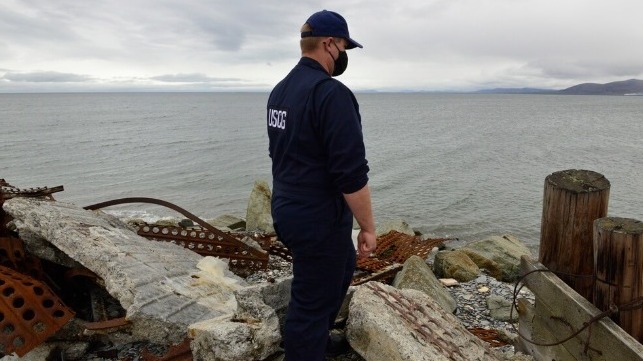On Annual Inspection Tour, USCG Witnesses Climate Change in Alaska

[By Petty Officer 1st Class Nate Littlejohn]
2021 marked a milestone for the Coast Guard’s Marine Safety Task Force initiative in Alaska. The seasonal MSTF initiative, first implemented in 2019, deploys Coast Guard teams to remote areas across the state to conduct vessel and facility inspections, provide operator training, improve maritime domain awareness, and conduct outreach for preparedness and safety programs.
Through MSTF operations, the Coast Guard observed firsthand the impacts of climate change to the landscape of the Arctic and Western portions of Alaska. As permafrost thaws, the ground under many aging fuel facilities is becoming unstable. This could potentially leave people unable to heat their homes and schools, or fuel their traditional hunting and fishing transportation. Potential fuel oil spills caused by aging infrastructure in rapidly changing landscapes threaten local ecosystems that sustain communities. Additionally, an increase in maritime traffic in the Arctic increases the potential for search and rescue or pollution cases.
"I had a very special opportunity to be part of an MSTF team that deployed to the island community of Little Diomede in October,” said Capt. Leanne Lusk, commander, Sector Anchorage. “Little Diomede is the closest location in the U.S. to Russia. The island has 98 residents, half of whom are children. We learned that they only receive one fuel delivery each year. We were there to inspect their fuel tanks to ensure they could survive the coming winter without a fuel or heating oil spill, and to talk about pollution response efforts in the Bering Strait should a spill ever occur. The residents we met described this increasingly-transited region as their ‘grocery store’ and explained the tragic impacts a major pollution incident would have on their village and their people.”
Inhabitants of Little Diomede subsist on blue king crab, walrus, seal, and an occasional polar bear, all harvested in the winter months when the ice is safe enough to walk on around the island. However, for the last seven years, the multi-year ice they have counted on for fishing and hunting for generations has receded substantially.
“Crabbing on winter ice is not so good anymore,” said Opik Ahkinga, environmental coordinator and vice-mayor on Little Diomede. “We are no longer able to access the locations where crabs are abundant . . . We are concerned that hunting for our traditional Inupiaq foods will be lost. For three years now, we have not seen full meat racks of oogruk (seal) and walrus. We are also concerned about the increased shipping near our island and the potential for groundings and possible oil spills. We do have mitigation plans, but we need to train everyone here on how to respond should an incident occur.”
An oil spill in a remote part of Alaska could potentially devastate nearby marine life and maritime communities, and remote pollution incidents require significantly more resources to clean up. A 3,000-gallon heavy fuel oil spill on Shuyak Island in 2019, just northeast of Kodiak Island, cost $9 million to clean up, the highest cost-per-gallon spill in U.S. history. In the winter of 2020-2021 there were a total of five spills in remote Alaskan communities, including one during a barge-over-the-water transfer that cost a community more than $60,000 in lost fuel alone.
Long-range logistics
In 2021, aircrews from the Alaska Army National Guard flew Coast Guard members from Joint Base Elmendorf-Richardson to hub communities, including King Salmon and Nome. From these hub communities, pilots from the Civil Air Patrol Alaska Wing flew MSTF members to remote communities, where runways only allow for smaller airplanes. In total, MSTF teams visited 95 remote communities, completed 128 fuel storage facility inspections, 470 commercial fishing vessel exams, five gold dredge exams, and monitored six fuel-to-shore transfers.
The direct result of the MSTF effort has been a 395 percent increase in physically inspected facilities and an almost 2,000 percent increase in vessel exams since the program's launch in 2019.
“Coastal erosion, changes to the home range of key species, increased commercial traffic, and thawing permafrost all have significant impacts on coastal communities and Coast Guard operations across various mission sets,” said Cmdr. Jereme Altendorf, an Arctic emergency management specialist at Sector Anchorage. “Via the MSTF initiative, the Coast Guard has positioned itself to not only complete its statutory missions, but simultaneously share the story of the effects of climate change with those who may be able to act.”
This article appears courtesy of U.S. Coast Guard News and is reproduced here in an abbreviated form. The original may be found here.
The opinions expressed herein are the author's and not necessarily those of The Maritime Executive.
